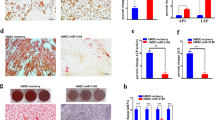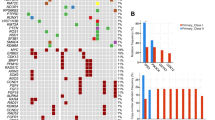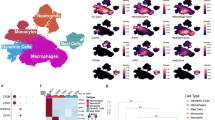Abstract
Background
Müllerian adenosarcoma (MA) is a rare tumour accounts for 5–7% of uterine sarcomas. Tumours with sarcomatous overgrowth (MASO) or high-grade tend to be aggressive. However, the tumour aetiology is elusive.
Methods
Single-cell RNA sequencing and bioinformatics were used to analyse the MASO and paired normal tissues. Expression and clinical significance of key genes were analysed by TCGA data and immunohistochemistry. In vitro experiment was used to verify the effect of E2F1 in cell dedifferentiation.
Results
We prove malignant stromal cells originate from fibrous tissue, Prom1-derived with complex intra-tumoral heterogeneity. Along the developmental trajectory, we discover three phenotypes of Prom1+ cancer cells (differentiation-like, intermediate-like, dedifferentiation-like). A distinct HMGB2/3+ subtype of Prom1+ cluster is predominant dedifferentiation-like cancer cells, with high proliferation and stemness traits at the tail of trajectory. E2F1 is a master transcription factor for Prom1 lineage dedifferentiation, which could occupy the HMGB2/3 promoter to enhance their transcription, facilitating the stemness and self-renewal of cancer cells. Gene signature of Prom1 lineage is associated with poorer prognosis in uterine malignancies. The expression of Prom1 and HMGB3 was verified by immunohistochemistry.
Conclusions
Our study reveal the heterogeneity and dynamics of Prom1 lineage cells, which are key to tailor efficient therapies for MASO.
This is a preview of subscription content, access via your institution
Access options
Subscribe to this journal
Receive 24 print issues and online access
269,00 € per year
only 11,21 € per issue
Buy this article
- Purchase on SpringerLink
- Instant access to full article PDF
Prices may be subject to local taxes which are calculated during checkout








Similar content being viewed by others
Data availability
The raw scRNA-seq data generated in this study have been deposited in the Genome Sequence Archive (GSA, https://ngdc.cncb.ac.cn/gsa/). The accession number is HRA008869. All other data supporting the findings of this study are available from the corresponding author upon reasonable request.
Code availability
The codes used in this study have been reported previously and are available as described in the corresponding “Methods” section.
References
D’Angelo E, Prat J. Uterine sarcomas: a review. Gynecol Oncol. 2010;116:131–9.
Clement PB, Scully RE. Müllerian adenosarcoma of the uterus: a clinicopathologic analysis of 100 cases with a review of the literature. Hum Pathol. 1990;21:363–81.
Verschraegen CF, Vasuratna A, Edwards C, Freedman R, Kudelka AP, Tornos C, et al. Clinicopathologic analysis of Müllerian adenosarcoma: the M.D. Anderson Cancer Center experience. Oncol Rep. 1998;5:939–44.
Gallardo A, Prat J. Müllerian adenosarcoma: a clinicopathologic and immunohistochemical study of 55 cases challenging the existence of adenofibroma. Am J Surg Pathol. 2009;33:278–88.
Hodgson A, Amemiya Y, Seth A, Djordjevic B, Parra-Herran C. High-grade Müllerian adenosarcoma: genomic and clinicopathologic characterization of a distinct neoplasm with prevalent TP53 pathway alterations and aggressive behavior. Am J Surg Pathol. 2017;41:1513–22.
Lee J, Lu T, Changou C, Liang CW, Huang HN, Lauria A, et al. Genomewide copy number analysis of Müllerian adenosarcoma identified chromosomal instability in the aggressive subgroup. Mod Pathol. 2016;29:1070–82.
Ban Y, Fischer J, Maniar K, Guo H, Zeng C, Li Y, et al. Whole-genome sequencing and target validation analysis of Müllerian adenosarcoma: a tumor with complex but specific genetic alterations. Front Oncol. 2020;10:538.
Mubeen A, Shahid M, Makary R. Post-radiation Müllerian adenosarcoma with sarcomatous overgrowth: rare presentation of an uncommon malignancy. Pathologica. 2020;112:219–23.
Regner MJ, Wisniewska K, Garcia-Recio S, Thennavan A, Mendez-Giraldez R, Malladi VS, et al. A multi-omic single-cell landscape of human gynecologic malignancies. Mol Cell. 2021;81:4924–41.e10.
Hornburg M, Desbois M, Lu S, Guan Y, Lo AA, Kaufman S, et al. Single-cell dissection of cellular components and interactions shaping the tumor immune phenotypes in ovarian cancer. Cancer Cell. 2021;39:928–44.e6.
Zheng X, Wang X, Cheng X, Liu Z, Yin Y, Li X, et al. Single-cell analyses implicate ascites in remodeling the ecosystems of primary and metastatic tumors in ovarian cancer. Nat Cancer. 2023;4:1138–56.
Liu C, Zhang M, Yan X, Ni Y, Gong Y, Wang C, et al. Single-cell dissection of cellular and molecular features underlying human cervical squamous cell carcinoma initiation and progression. Sci Adv. 2023;9:eadd8977.
Ren X, Liang J, Zhang Y, Jiang N, Xu Y, Qiu M, et al. Single-cell transcriptomic analysis highlights origin and pathological process of human endometrioid endometrial carcinoma. Nat Commun. 2022;13:6300.
Yu Z, Zhang J, Zhang Q, Wei S, Shi R, Zhao R, et al. Single-cell sequencing reveals the heterogeneity and intratumoral crosstalk in human endometrial cancer. Cell Prolif. 2022;55:e13249.
Klümper N, Ralser DJ, Ellinger J, Roghmann F, Albrecht J, Below E, et al. Membranous NECTIN-4 expression frequently decreases during metastatic spread of urothelial carcinoma and is associated with enfortumab vedotin resistance. Clin Cancer Res. 2023;29:1496–505.
Jiang S, Zheng JF, Cui ZL, Li Y, Wu Q, Cai X, et al. FBXO5 acts as a novel prognostic biomarker for patients with cervical cancer. Front Cell Dev Biol. 2023;11:1200197.
Zhu HY, Bai WD, Li C, Zheng Z, Guan H, Liu JQ, et al. Knockdown of lncRNA-ATB suppresses autocrine secretion of TGF-β2 by targeting ZNF217 via miR-200c in keloid fibroblasts. Sci Rep. 2016;6:24728.
Howitt B, Sholl L, Dal Cin P, Jia Y, Yuan L, MacConaill L, et al. Targeted genomic analysis of Müllerian adenosarcoma. J Pathol. 2015;235:37–49.
Wei JJ. HMGA2: a biomarker in gynecologic neoplasia. J Clin Transl Pathol. 2022;2:3–7.
Lee J, Shin JE, Lee B, Kim H, Jeon Y, Ahn SH, et al. The stem cell marker Prom1 promotes axon regeneration by down-regulating cholesterol synthesis via Smad signaling. Proc Natl Acad Sci USA. 2020;117:15955–66.
Saraswathibhatla A, Indana D, Chaudhuri O. Cell-extracellular matrix mechanotransduction in 3D. Nat Rev Mol Cell Biol. 2023;24:495–516.
Le Saux G, Wu MC, Toledo E, Chen YQ, Fan YJ, Kuo JC, et al. Cell-cell adhesion-driven contact guidance and its effect on human mesenchymal stem cell differentiation. ACS Appl Mater Interfaces. 2020;12:22399–409.
Luo W, Lin Z, Chen J, Chen G, Zhang S, Liu M, et al. TMEM182 interacts with integrin beta 1 and regulates myoblast differentiation and muscle regeneration. J Cachexia Sarcopenia Muscle. 2021;12:1704–23.
Jamasbi E, Hamelian M, Hossain MA, Varmira K. The cell cycle, cancer development and therapy. Mol Biol Rep. 2022;49:10875–83.
Milanovic M, Fan DNY, Belenki D, Däbritz JHM, Zhao Z, Yu Y, et al. Senescence-associated reprogramming promotes cancer stemness. Nature. 2018;553:96–100.
Taniguchi N, Caramés B, Hsu E, Cherqui S, Kawakami Y, Lotz M, et al. Expression patterns and function of chromatin protein HMGB2 during mesenchymal stem cell differentiation. J Biol Chem. 2011;286:41489–98.
Wen B, Wei YT, Zhao K. The role of high mobility group protein B3 (HMGB3) in tumor proliferation and drug resistance. Mol Cell Biochem. 2021;476:1729–39.
Pan XW, Zhang H, Xu D, Chen JX, Chen WJ, Gan SS, et al. Identification of a novel cancer stem cell subpopulation that promotes progression of human fatal renal cell carcinoma by single-cell RNA-seq analysis. Int J Biol Sci. 2020;16:3149–62.
Zhao X, Li H, Lyu S, Zhai J, Ji Z, Zhang Z, et al. Single-cell transcriptomics reveals heterogeneous progression and EGFR activation in pancreatic adenosquamous carcinoma. Int J Biol Sci. 2021;17:2590–605.
Wen J, Tan D, Li L, Wang X, Pan M, Guo J. RhoA regulates Schwann cell differentiation through JNK pathway. Exp Neurol. 2018;308:26–34.
Theodossiou SK, Murray JB, Schiele NR. Cell-cell junctions in developing and adult tendons. Tissue Barriers. 2020;8:1695491.
Zhao Z, Zhang Y, Zhang C, Zhang J, Luo X, Qiu Q, et al. TGF-β promotes pericyte-myofibroblast transition in subretinal fibrosis through the Smad2/3 and Akt/mTOR pathways. Exp Mol Med. 2022;54:673–84.
Van de Sande B, Flerin C, Davie K. A scalable SCENIC workflow for single-cell gene regulatory network analysis. Nat Protoc. 2020;15:2247–76.
Meng P, Ghosh R. Transcription addiction: can we garner the Yin and Yang functions of E2F1 for cancer therapy? Cell Death Dis. 2014;5:e1360.
Shang C, Lang B, Meng LR. Blocking NOTCH pathway can enhance the effect of EGFR inhibitor through targeting CD133+ endometrial cancer cells. Cancer Biol Ther. 2018;19:113–9.
Kitson SJ, Rosser M, Fischer DP, Marshall KM, Clarke RB, Crosbie EJ. Targeting endometrial cancer stem cell activity with metformin is inhibited by patient-derived adipocyte-secreted factors. Cancers. 2019;11:653.
Malta TM, Sokolov A, Gentles AJ, Burzykowski T, Poisson L, Weinstein JN, et al. Machine learning identifies stemness features associated with oncogenic dedifferentiation. Cell. 2018;173:338–54.e15.
Yu X, Xie L, Ge J, Li H, Zhong S, Liu X. Integrating single-cell RNA-seq and spatial transcriptomics reveals MDK-NCL dependent immunosuppressive environment in endometrial carcinoma. Front Immunol. 2023;14:1145300.
Filippou PS, Karagiannis GS, Constantinidou A. Midkine (MDK) growth factor: a key player in cancer progression and a promising therapeutic target. Oncogene. 2020;39:2040–54.
Ling T, Zhang C, Liu Y, Jiang C, Gu L. Single-cell analysis revealed a potential role of T-cell exhaustion in colorectal cancer with liver metastasis. J Cell Mol Med. 2024;28:e18341.
Hardbower DM, Coburn LA, Asim M, Singh K, Sierra JC, Barry DP, et al. EGFR-mediated macrophage activation promotes colitis-associated tumorigenesis. Oncogene. 2017;36:3807–19.
Zhang Y, Bai Y, Ma XX, Song JK, Luo Y, Fei XY, et al. Clinical-mediated discovery of pyroptosis in CD8+ T cell and NK cell reveals melanoma heterogeneity by single-cell and bulk sequence. Cell Death Dis. 2023;14:553.
Jiang X, Chen N, Wei Q, Luo X, Liu X, Xie L, et al. Single-cell RNA sequencing and cell-cell communication analysis reveal tumor microenvironment associated with chemotherapy responsiveness in ovarian cancer. Clin Transl Oncol. 2024. https://doi.org/10.1007/s12094-024-03655-6.
Pawig L, Klasen C, Weber C, Bernhagen J, Noels H. Diversity and inter-connections in the CXCR4 chemokine receptor/ligand family: molecular perspectives. Front Immunol. 2015;6:429.
Zhou M, Lu F, Jiang L, Chen C, Chen S, Geng L, et al. Decoding the intercellular cross-talking between immune cells and renal innate cells in diabetic kidney disease by bioinformatics. J Inflamm Res. 2023;16:3049–62.
Matsuzaki S, Klar M, Matsuzaki S, Roman LD, Sood AK, Matsuo K. Uterine carcinosarcoma: contemporary clinical summary, molecular updates, and future research opportunity. Gynecol Oncol. 2021;160:586–601.
Choijamts B, Jimi S, Kondo T, Naganuma Y, Matsumoto T, Kuroki M, et al. CD133+ cancer stem cell-like cells derived from uterine carcinosarcoma (malignant mixed Müllerian tumor). Stem Cells. 2011;29:1485–95.
de Kock L, Yoon JY, Apellaniz-Ruiz M, Pelletier D, McCluggage WG, Stewart CJR, et al. Significantly greater prevalence of DICER1 alterations in uterine embryonal rhabdomyosarcoma compared to adenosarcoma. Mod Pathol. 2020;33:1207–19.
Stevens BT, Hatley ME. Developmental heterogeneity of rhabdomyosarcoma. Cold Spring Harb Perspect Med. 2024;21:a041583.
Wei Y, Qin Q, Yan C, Hayes MN, Garcia SP, Xi H, et al. Single-cell analysis and functional characterization uncover the stem cell hierarchies and developmental origins of rhabdomyosarcoma. Nat Cancer. 2022;3:961–75.
Broz MT, Ko EY, Ishaya K, Xiao J, De Simone M, Hoi XP, et al. Metabolic targeting of cancer associated fibroblasts overcomes T-cell exclusion and chemoresistance in soft-tissue sarcomas. Nat Commun. 2024;15:2498.
Unachukwu U, Chada K, D’Armiento J. High Mobility Group AT-Hook 2 (HMGA2) oncogenicity in mesenchymal and epithelial neoplasia. Int J Mol Sci. 2020;21:3151.
Ke XY, Chen Y, Tham VY, Lin RY, Dakle P, Nacro K, et al. MNK1 and MNK2 enforce expression of E2F1, FOXM1, and WEE1 to drive soft tissue sarcoma. Oncogene. 2021;40:1851–67.
Yeo HC, Beh TT, Quek JJ, Koh G, Chan KK, Lee DY. Integrated transcriptome and binding sites analysis implicates E2F in the regulation of self-renewal in human pluripotent stem cells. PLoS ONE. 2011;6:e27231.
Campbell PA, Rudnicki MA. Oct4 interaction with Hmgb2 regulates Akt signaling and pluripotency. Stem Cells. 2013;31:1107–20.
Zhuang S, Yu X, Lu M, Li Y, Ding N, Ding Y. High mobility group box 3 promotes cervical cancer proliferation by regulating Wnt/beta-catenin pathway. J Gynecol Oncol. 2020;31:e91.
Li Y, Ma Y, Zhang T, Feng C, Liu Y. High-mobility group box 3 (HMGB3) silencing inhibits non-small cell lung cancer development through regulating Wnt/beta-catenin pathway. Biol Chem. 2020;401:1191–8.
Zhang Z, Chang Y, Zhang J, Lu Y, Zheng L, Hu Y, et al. HMGB3 promotes growth and migration in colorectal cancer by regulating WNT/beta-catenin pathway. PLoS ONE. 2017;12:e0179741.
Zhang C, Fondufe-Mittendorf YN, Wang C, Chen J, Cheng Q, Zhou D, et al. Latexin regulation by HMGB2 is required for hematopoietic stem cell maintenance. Haematologica. 2020;105:573–84.
Starkova T, Polyanichko A, Tomilin AN, Chikhirzhina E. Structure and functions of HMGB2 protein. Int J Mol Sci. 2023;24:8334.
Yuan L, Tian X, Zhang Y, Huang X, Li Q, Li W, et al. LINC00319 promotes cancer stem cell-like properties in laryngeal squamous cell carcinoma via E2F1-mediated upregulation of HMGB3. Exp Mol Med. 2021;53:1218–28.
Fedele M, Visone R, De Martino I, Troncone G, Palmieri D, Battista S, et al. HMGA2 induces pituitary tumorigenesis by enhancing E2F1 activity. Cancer Cell. 2006;9:459–71.
Dong J, Wang R, Ren G, Li X, Wang J, Sun Y, et al. HMGA2-FOXL2 axis regulates metastases and epithelial-to-mesenchymal transition of chemoresistant gastric cancer. Clin Cancer Res. 2017;23:3461–73.
Xia Y, Lv J, Jiang T, Li B, Li Y, He Z, et al. CircFAM73A promotes the cancer stem cell-like properties of gastric cancer through the miR-490-3p/HMGA2 positive feedback loop and HNRNPK-mediated β-catenin stabilization. J Exp Clin Cancer Res. 2021;40:103.
Funding
This work was supported by Major Scientific Research Program for Young and Middle-aged Health Professionals of Fujian Province, China (2022ZQNZD008); Joint Funds for the Innovation of Science and Technology, Fujian Province, China (2021Y9209); Funds for Advanced Cancer Center, Fujian Province, China (F2125Y-GSP02-01); National Natural Science Foundation of China (82374081); High-level Talents Training Project of Fujian Cancer Hospital (2022YNG04); the Natural Science Foundation of Fujian Province (2024J011096, 2024J011098); Innovative Medicine Subject of Fujian Provincial Health Commission (2024CXA034).
Author information
Authors and Affiliations
Contributions
Xingming Ye, Jianfeng Zheng and Li Liu conceived and designed this study; Dan Hu and Jie Lin performed pathological examinations; Xingming Ye, Jianfeng Zheng, Fukun Chen and Lifeng Li analysed the data; Qinying Liu and Yangmei Xu wrote the manuscript; Dan Hu, Xintong Cai and Jianfeng Zheng collected the samples and conducted the experiments; Yang Sun provided funding and offered administrative support. All authors read and approved the final manuscript.
Corresponding author
Ethics declarations
Competing interests
The authors declare no competing interests.
Ethics approval and consent to participate
This study was conducted in compliance with institutional policy to protect patients’ private information and was approved by the Institutional Review Board of Fujian Cancer Hospital (K2022-052-01), informed consent was also obtained from each patient.
Additional information
Publisher’s Note Springer Nature remains neutral with regard to jurisdictional claims in published maps and institutional affiliations.
Supplementary information
Rights and permissions
Springer Nature or its licensor (e.g. a society or other partner) holds exclusive rights to this article under a publishing agreement with the author(s) or other rightsholder(s); author self-archiving of the accepted manuscript version of this article is solely governed by the terms of such publishing agreement and applicable law.
About this article
Cite this article
Ye, X., Zheng, J., Hu, D. et al. Identification of increased dedifferentiation along the Prom1+ cancer cells in Müllerian adenosarcoma with sarcomatous overgrowth. Br J Cancer 132, 438–449 (2025). https://doi.org/10.1038/s41416-025-02943-4
Received:
Revised:
Accepted:
Published:
Issue Date:
DOI: https://doi.org/10.1038/s41416-025-02943-4



